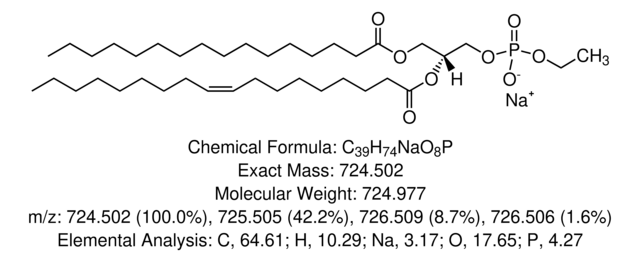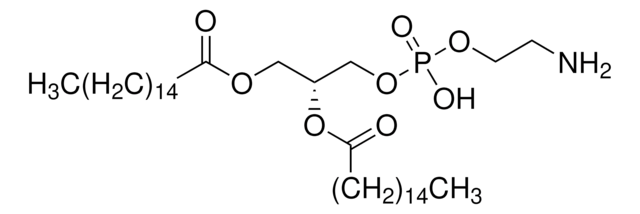850699C
Avanti
08:0 PE
1,2-dioctanoyl-sn-glycero-3-phosphoethanolamine, chloroform
Synonyme(s) :
PE(8:0/8:0)
About This Item
Produits recommandés
Essai
>99% (TLC)
Forme
liquid
Conditionnement
pkg of 1 × 1 mL (850699C-10mg)
pkg of 1 × 2.5 mL (850699C-25mg)
pkg of 1 × 20 mL (850699C-500mg)
Fabricant/nom de marque
Avanti Research™ - A Croda Brand 850699C
Concentration
10 mg/mL (850699C-10mg)
10 mg/mL (850699C-25mg)
25 mg/mL (850699C-500mg)
Conditions d'expédition
dry ice
Température de stockage
−20°C
Chaîne SMILES
[H][C@@](COP([O-])(OCC[NH3+])=O)(OC(CCCCCCC)=O)COC(CCCCCCC)=O
Description générale
Application
Actions biochimiques/physiologiques
Conditionnement
Informations légales
Mention d'avertissement
Danger
Mentions de danger
Classification des risques
Acute Tox. 3 Inhalation - Acute Tox. 4 Oral - Carc. 2 - Eye Irrit. 2 - Repr. 2 - Skin Irrit. 2 - STOT RE 1 Oral - STOT SE 3
Organes cibles
Liver,Kidney, Respiratory system
Code de la classe de stockage
6.1D - Non-combustible acute toxic Cat.3 / toxic hazardous materials or hazardous materials causing chronic effects
Classe de danger pour l'eau (WGK)
WGK 3
Point d'éclair (°F)
does not flash
Point d'éclair (°C)
does not flash
Faites votre choix parmi les versions les plus récentes :
Certificats d'analyse (COA)
Désolés, nous n'avons pas de COA pour ce produit disponible en ligne pour le moment.
Si vous avez besoin d'assistance, veuillez contacter Service Clients
Déjà en possession de ce produit ?
Retrouvez la documentation relative aux produits que vous avez récemment achetés dans la Bibliothèque de documents.
Notre équipe de scientifiques dispose d'une expérience dans tous les secteurs de la recherche, notamment en sciences de la vie, science des matériaux, synthèse chimique, chromatographie, analyse et dans de nombreux autres domaines..
Contacter notre Service technique










